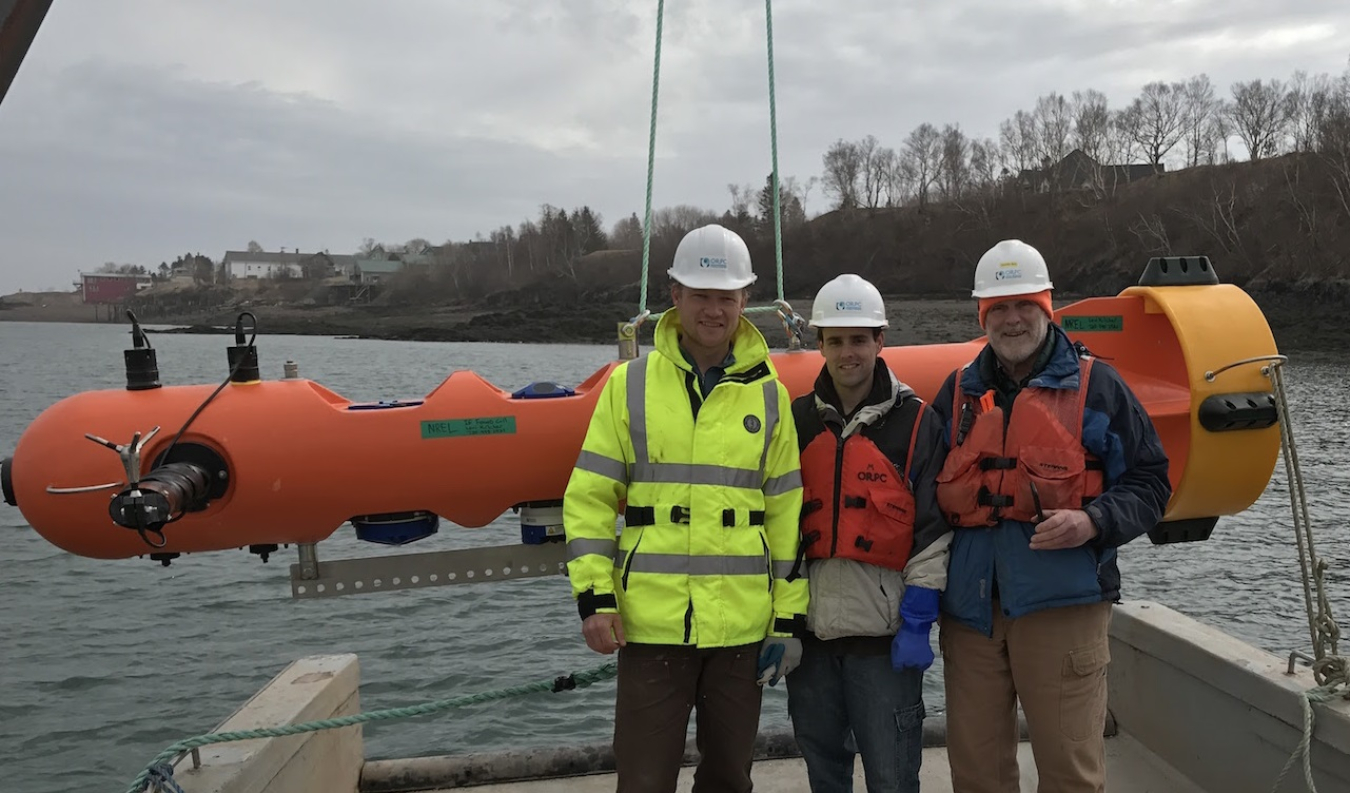
Levi Kilcher of National Renewable Energy Laboratory and Sean Anderton and Bob Lewis of Ocean Renewable Power Company, a subcontractor on the project, prepare to deploy a water turbulence measuring system in the Bay of Fundy, near Eastport, Maine. The area has a strong tidal energy resource.
The National Renewable Energy Laboratory (NREL) has deployed buoys with high-accuracy sensors to record wave and tide movement off the coasts of Oregon and Maine, in areas known to be potential hot spots for marine and hydrokinetic (MHK) energy development. Researchers aim to collect data that will support industry’s efforts to deploy MHK devices.
The work is part of larger project funded by the Department of Energy, in concert with Sandia National Laboratories and the Pacific Northwest National Laboratory, to analyze wave and tidal energy sites with great potential for development and gather data to validate the computer modeling tools that industry uses to design devices. New data will fill gaps in existing measurements.
“The data will be publicly available, so device developers can use it in device simulations to test and improve their technology,” said Levi Kilcher, project manager at NREL. “They can also use the data to design arrays of devices.”
The research corresponds with the Water Power Technologies Office’s goal to support, with early-stage research, industry development of energy technologies that have potential to provide reliable and secure energy from local MHK resources.
Tidal measurements in Maine
Tidal energy devices convert energy from the ebb and flow of tides. An inlet off the Bay of Fundy, near Eastport, Maine, has a strong tidal resource—with the potential to generate an estimated 180 MW of renewable MHK energy—making it an attractive location for future development.
NREL recently deployed three subsurface buoys that will measure underwater tidal water speeds and turbulence, an area of research lacking sufficient data. A lot like air turbulence, underwater turbulence can wreak havoc on structures not adequately equipped to deal with it. Underwater turbulence is created by irregularities in the river environment, such as land masses or seafloor roughness.
“Just the way air turbulence shakes a plane, it also shakes wind turbines—and it does the same thing to tidal energy turbines,” Kilcher said. “We are measuring the turbulence so that device simulations are based on realistic conditions, which will help engineers design robust and economical devices.”
One of the buoys is outfitted with advanced sensing technology developed by NREL in another project. Instead of erecting an expensive tower under water—the most accurate way to measure turbulence—the buoy is connected to a mooring system with cables. Sensors record the buoy’s movements, and a sophisticated algorithm separates that motion from turbulence. The buoy will be positioned about 30 feet above the seafloor, imitating the depth of tidal turbines.
It joins two other buoys, known as bottom-landers, which measure tidal flow and turbulence throughout the water column—a vertical slice of water—from the seafloor. Together with the high-accuracy buoy measurements, the bottom landers provide a more complete picture of the turbulence in the channel and help researchers understand where the most energetic locations of the river are located.
Wave measurements in Oregon
Wave energy devices convert energy from waves into electricity. Two measurement buoys deployed off the Oregon coast—where the U.S. wave resource is particularly energetic—will assist in validating computer models for wave energy deployments in shallow waters. To date, most West Coast wave energy measurements have been made in deeper water.
The buoys use a well-known system of accelerometers, similar to those in a smartphone, which can detect motion in all directions. The data will indicate a wave’s height, length, frequency, and direction of travel. The buoys will occasionally be relocated to other promising wave sites.
For example, NREL researchers will deploy buoys off Alaska and California this year. The rotation of sensors allows researchers to maximize the spatial-reach and relevance of the measurement effort. Alaska and California each have significant MHK resources with high potential for development.
Previous analysis of wave and tidal energy resources relied primarily on publicly available data or low-fidelity measurements from boats. These high-fidelity studies focusing on regions with high wave energy development potential will reduce risk and cost for developers, who will be freed from conducting their own measurements deemed by the MHK industry as too costly to perform.
The Office of Energy Efficiency and Renewable Energy accelerates development and deployment of energy efficiency and renewable energy technologies and market-based solutions that strengthen U.S. energy security, environmental quality, and economic vitality. Visit water.energy.gov to learn more about the Water Power Technologies Office.

